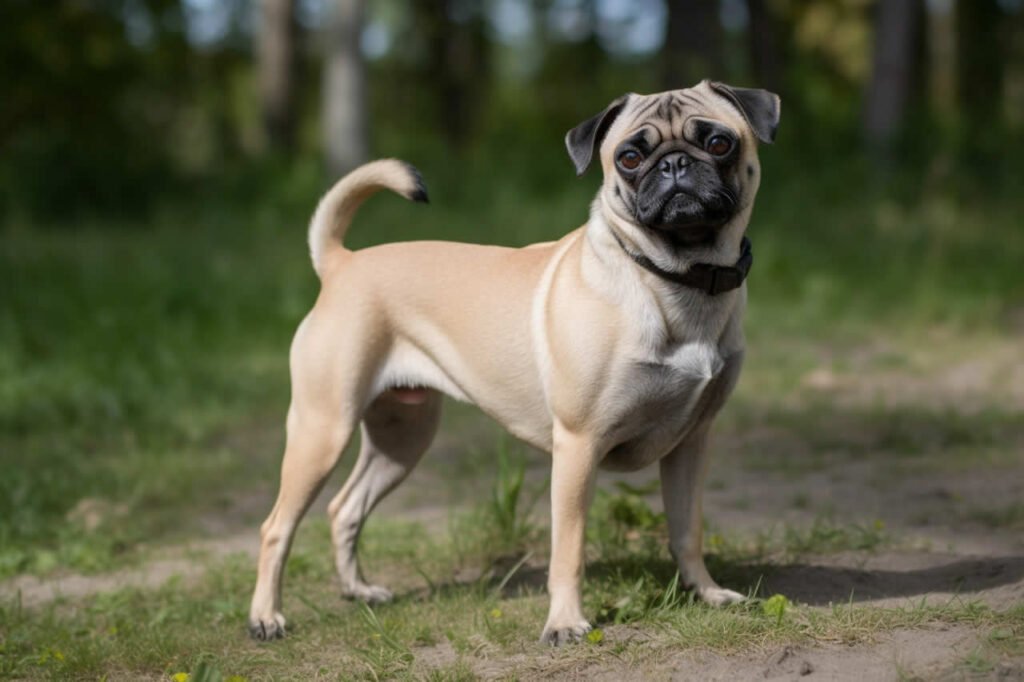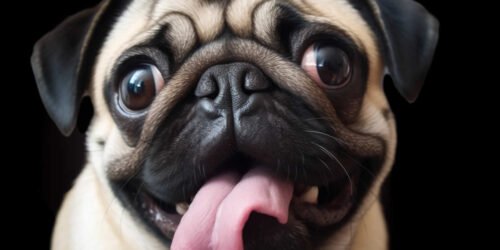Why Is My Pug Tall And Skinny?
Introduction
Welcome fellow Pug lovers! Have you ever wondered why some of our beloved, snorty friends are taller and skinnier than the typical pug we’re used to? You’re not alone! In this blog post, we’ll dive into the fascinating world of Pug body types and explore the factors that could cause your Pug to have long legs and a lean frame.
We’ll also share some important tips for maintaining a healthy weight in your precious furball.
Table of Contents
- Introduction
- Understanding Pug Body Types
- Causes Of Tall And Skinny Pugs
- How To Tell If Your Pug Is Underweight
- Conclusion And Key Takeaways For Pug Owners
Key Takeaways
- Pug body shape varies, but a typical healthy Pug has a sturdy and barrel – shaped body with short legs, weighing around 14 to 18 pounds when fully grown.
- Genetics and breeding can play a significant role in determining your Pug’s overall build and stature. Avoid breeders who prioritize profit over ethical practices.
- Insufficient nutrition, inadequate diet, and health problems such as thyroid disorders may contribute to tall and skinny pugs. Provide appropriate diet/nutrition based on veterinary recommendations, ensure regular exercise/playtime for maintaining optimal health. Regular checkups are crucial for early detection of any underlying health issues in your furry friend.

Understanding Pug Body Types
Pug body shape varies, but a typical Pug has a barrel-shaped chest, short legs, and a round head with wrinkles.
Typical Pug Body Shape
As a proud pug enthusiast, I can’t help but adore the typical Pug body shape – it’s simply irresistible! Pugs are known for their small, sturdy, and barrel-shaped bodies with relatively short legs.
They have wide chests that provide ample support for their square frame.
In addition to their iconic facial features, one of the most recognizable characteristics of a healthy Pug is its curly tail, which gracefully coils over its back. A typical Pug’s height ranges from 10 to 13 inches tall and weighs around 14 to 18 pounds when fully grown.
This compact yet substantial physique lends itself well to being an affectionate lap dog while still being capable of plenty of playtime antics with family members.
Factors Affecting Pug Size, Including Genetics And Health Issues
As a pug enthusiast and SEO copywriter, I have come across various factors that influence a Pug’s size and appearance. One of the main aspects is genetics, which can play a significant role in determining your pet Pug’s overall build and stature.
Health issues also contribute to variations seen in Pugs’ physique – especially regarding height and weight. A prime example is hip joint deformities mentioned earlier; these genetic health problems may affect Pugs by causing abnormal growth patterns in their legs (making them appear taller).
Furthermore, allergies common among Pugs might lead to selective diet plans for certain individuals – consequently impacting their weight gain or loss over time. Lastly, stomach problems unique to the breed like sensitivity towards specific foods or intolerance might cause rapid fluctuations in body weight from time to time.
Causes Of Tall And Skinny Pugs
Tall and skinny pugs can be caused by genetics and breeding, insufficient nutrition, or health issues like thyroid problems – read on to learn more about how to identify if your pug is underweight and what you can do to help.
Genetics And Breeding
As a pug enthusiast, you might be curious about how genetics and breeding play significant roles in your tall and skinny pug’s appearance. The reason behind this unique stature is rooted in several genetic factors that impact their weight, size, and overall body structure.
Unfortunately, the world of dog breeding has its drawbacks too. Breeders striving to meet breed standards or produce distinct physical features sometimes engage in harmful practices like inbreeding or excessive line-breeding.
This could result in unforeseen genetic abnormalities manifesting as health issues down the line – not just limited to your pug’s unusual body type but possibly affecting other aspects such as their susceptibility to brachycephalic obstructive airway syndrome.
Insufficient Nutrition And Diet
Maintaining a balanced diet is crucial for every dog’s health, and Pugs are no exception. Insufficient nutrition can lead to weight loss and a tall, skinny appearance in Pugs.
As a Pug owner myself, I know how tempting it can be to spoil our furry friends with treats and table scraps. However, overeating or consuming unhealthy foods can have negative consequences on their health.
Additionally, certain health problems that commonly affect Pugs like Brachycephalic Airway Obstruction Syndrome (BAOS) can also be exacerbated by inadequate nutrition and diet.
Health Issues, Such As Thyroid Problems And Growth Abnormalities
As a pug owner, it’s essential to understand the potential health issues that can arise in these adorable dogs. Thyroid problems and growth abnormalities are two conditions that may impact pugs’ height and weight, leading to a tall and skinny appearance.
Hypothyroidism is a common thyroid disorder that affects many dog breeds, including pugs. This condition occurs when the thyroid gland doesn’t produce enough hormones, which can lead to systemic changes in dogs.
Growth abnormalities may also affect pug size and body shape. These issues can be caused by factors such as genetics or nutritional deficiencies during key developmental stages.
It’s crucial for pet owners to monitor their pug’s eating habits closely and ensure they receive balanced nutrition throughout their lives.
How To Tell If Your Pug Is Underweight
To determine if your pug is underweight, check for visible ribs and bones, observe their eating habits, and identify any signs of health issues; learn more about maintaining a healthy weight for your furry friend in the next section.
Checking For Visible Ribs And Bones
To determine if your Pug is underweight, it’s important to check for visible ribs and bones. A healthy Pug should have a waistline, but not be too skinny or overweight. You can feel for their ribs by placing your hands on either side of their chest and gently pressing down with your fingertips.
One way to tell if a Pug is underweight is by checking if there are too many visible ribs, meaning that there isn’t much muscle or fat between the skin and ribcage. Feeling the spine can also help determine if they are underweight or overweight.
However, dogs with long hair may have less visible ribs but can still be underweight, so it’s essential to feel around for them.
[Keywords: visible ribs, underweight pug]
Observing Eating Habits
One of the easiest ways to determine if your pug is underweight is by observing their eating habits. Pugs are known for their love of food and may have a large appetite, but if they are not maintaining a healthy weight, it could be due to an underlying issue.
A pug who eats slowly or seems uninterested in food may indicate health problems, while overeating can lead to obesity. If you’re concerned about your pug’s weight, monitor their eating habits closely and consult with a veterinarian for advice on the appropriate diet and feeding schedule.
Identifying Signs Of Health Issues
As a pug owner, it’s crucial to monitor your furry friend’s health and be able to identify any signs of underlying medical issues. If you notice sudden weight loss or a lack of appetite in your pug, this could indicate malnourishment, neglect, or other health problems such as worms or parasites.
It’s important to note that unexplained weight loss in Pugs might also be an indication of thyroid problems and growth abnormalities. Therefore regular checkups with the vet are essential for maintaining good health for your pet pug.
Providing A Balanced Diet With Proper Nutrition
As a Pug owner, one of the most important things you can do to maintain your furry friend’s health is providing them with a balanced diet. This means feeding them food that contains all the necessary nutrients they need to thrive.
To ensure balanced nutrition, consider using a holistic dog food that incorporates proteins, whole grains, vegetables, and fruits. Look for brands that are specially formulated for small breeds like Pugs and avoid those with fillers like corn or soy.
Remember that portion control is just as important as what you’re actually feeding your pup – measure out their meals rather than free-feeding throughout the day.
Ensuring Regular Exercise And Playtime
As a pug owner, it’s important to ensure that your furry friend gets regular exercise and playtime. Pugs are prone to weight gain and health issues if they don’t get enough physical activity.
I make sure to take my pug for at least two 20-minute walks each day, but there are plenty of other activities you can do with your pup as well. For example, taking them to the dog park or letting them play in the backyard can be great ways for them to burn off energy.
Regular exercise also helps keep them happy and calm throughout the day.
Monitoring Weight And Seeking Veterinary Advice If Necessary
As a responsible Pug owner, it’s crucial to keep an eye on your furry friend’s weight and health regularly. Regularly checking for visible ribs and monitoring eating habits are essential indicators that could help you identify if your Pug is underweight.
If you suspect any concerns about your Pug’s weight, seeking veterinary advice is critical to prevent potential health risks from obesity or other underlying conditions. During routine check-ups with the vet, they can advise on appropriate nutrition, diet, exercise routines that suit your pet’s needs at their present weight and age.
Seeking regular veterinary care is also vital for maintaining overall well-being and preventing health problems like thyroid problems or growth abnormalities seen in some pugs.
Conclusion And Key Takeaways For Pug Owners
In conclusion, discovering that your pug is tall and skinny may raise concerns about their health and well-being. However, it is important to understand the various factors that can contribute to a pug’s size and shape.
While genetics and breeding play a significant role in determining a pug’s body type, insufficient nutrition and health issues can also be contributing factors. As responsible pet owners, it is essential to monitor our pugs’ weight and provide them with proper nutrition and exercise to maintain optimal health.
Remember to seek veterinary advice if you suspect any underlying health issues or abnormalities in your pug’s appearance.
FAQs:
1. Is it normal for a pug to be tall and skinny?
No, it is not typical for a pug to be tall and skinny as the breed’s standard is short and stocky with a muscular build.
2. What could be causing my pug to appear taller and thinner than usual?
There are several potential causes of this appearance in your pug, including genetics, age-related changes like loss of muscle mass or changes in body composition due to health issues such as thyroid problems or digestive disorders.
3. How can I help my tall and skinny pug gain weight and improve their overall health?
Consulting with your vet will help determine the best course of action for addressing any underlying health concerns that may be contributing to your pet’s weight loss or poor body condition. This might include changing their diet, increasing exercise levels or medication if necessary.
4. Can overfeeding cause a pug to become too thin despite eating frequently?
Overfeeding alone is unlikely to cause a pug dog’s fat tissue atrophy which leads them appearing taller & leaner but excess feeding may lead dogs towards digestion difficulties which eventually deteriorate their metabolism resulting in further weight/health complications so always consult with an experienced veterinarian before dramatically altering dietary habits.






